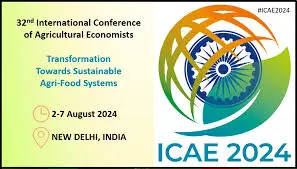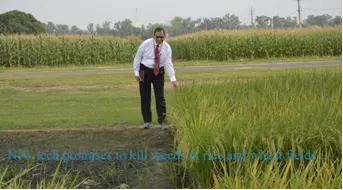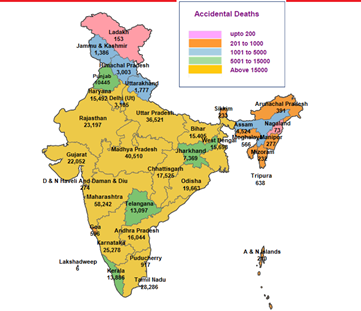Thursday, 8th August 2024
Supreme Court to review PMLA verdict
Why in the news?
- The Supreme Court has deferred to August 28 reviewing its decision to uphold key provisions of the Prevention of Money Laundering Act, 2002 (PMLA).
- A three-judge special bench comprising Justices Surya Kant, C T Ravikumar, and Ujjal Bhuyan will hear the case.
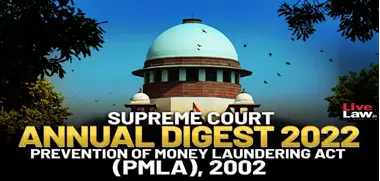
What about the Prevention of Money Laundering Act, 2002?
- About:
- The Prevention of Money Laundering Act, 2002 (PMLA) is a key legislation in India designed to prevent and address money laundering and related financial crimes. It provides a comprehensive legal framework for:
- Preventing Money Laundering: Addressing and mitigating activities related to money laundering.
- Confiscating Property: Seizing and confiscating property derived from or involved in money laundering.
- The Prevention of Money Laundering Act, 2002 (PMLA) is a key legislation in India designed to prevent and address money laundering and related financial crimes. It provides a comprehensive legal framework for:
- Applicability: The provisions of the PMLA are applicable to various entities, including:
- Financial institutions
- Banks (including the Reserve Bank of India)
- Mutual funds
- Insurance companies
- Financial intermediaries
- PMLA (Amendment) Act, 2012:
- Concept of ‘Reporting Entity’: The amendment introduced the term 'reporting entity,' encompassing banking companies, financial institutions, intermediaries, etc.
- Removal of Fine Limit: The upper limit of ₹5 lakh on fines was removed.
- Provisional Attachment: The Act now allows for the provisional attachment and confiscation of property involved in money laundering activities.
Enforcement Directorate (ED):
- History:
- Formation: The Enforcement Directorate (ED) was established on May 1, 1956, as an 'Enforcement Unit' within the Department of Economic Affairs to handle violations of foreign exchange laws under the Foreign Exchange Regulation Act, 1947 (FERA '47).
- Evolution: With economic liberalisation, FERA, 1973 was repealed and replaced by the Foreign Exchange Management Act, 1999 (FEMA). The ED's role expanded to encompass various economic offences.
- Fugitive Economic Offenders Act, 2018 (FEOA): This Act empowered the ED to enforce the attachment and confiscation of properties belonging to fugitive economic offenders who evade arrest.
- Functions:
- Under the Prevention of Money Laundering Act, 2002 (PMLA):
- Investigate to trace assets derived from crime proceeds.
- Provisionally attach property and ensure prosecution.
- Facilitate the confiscation of property through Special Courts.
- Under the Foreign Exchange Management Act, 1999 (FEMA):
- Investigate suspected violations of foreign exchange laws.
- Adjudicate and impose penalties for contraventions.
- Under the Fugitive Economic Offenders Act, 2018 (FEOA):
- Attach properties of fugitive economic offenders who have fled the country.
- Confiscate properties and transfer them to the Central Government.
- Under the Conservation of Foreign Exchange and Prevention of Smuggling Activities Act, 1974 (COFEPOSA):
- Sponsor cases for preventive detention related to FEMA contraventions.
- Under the Prevention of Money Laundering Act, 2002 (PMLA):
Case Overview: Vijay Madanlal Choudhary v. Union of India
- About:
- In the case of Vijay Madanlal Choudhary v. Union of India, the Supreme Court upheld key provisions of the Prevention of Money Laundering Act, 2002 (PMLA).
- The court’s 540-page ruling supported the government’s stance on several contentious aspects:
- Bail Provisions: Reversed the presumption of innocence for bail purposes.
- Legislative Process: Validated the passing of amendments to the PMLA as a Money Bill under the Finance Act.
- Powers of the Enforcement Directorate (ED): Defined the scope of ED’s powers.
- Review Petition:
- Petitioner: Congress MP Karti Chidambaram
- Date of Petition: August 25, 2022
- Bench: Chief Justice of India N.V. Ramana, Justices Dinesh Maheshwari, C.T. Ravikumar
Issues Raised:
- Bail Provisions:
- The petitioners argue that the Supreme Court’s decision upholding the reverse burden of proof for bail under PMLA is problematic.
- They contend that without essential documents like FIRs, charge sheets, or case diaries, an accused cannot adequately defend themselves.
- Powers of the Enforcement Directorate (ED):
- The petitioners claim that the ruling inadequately considered certain provisions granting penal powers to the ED.
- The verdict upheld Section 50 of the PMLA, which allows ED officials to record statements on oath, which are admissible in court.
- The petitioners argue that this classification of ED officers as not being “police officers” and the treatment of their investigations as “inquiries” is flawed.
Judgment Review Process:
- Article 137 of the Constitution:
- The Supreme Court can review its judgments or orders under Article 137.
- A review petition must be filed within 30 days of the judgement.
- Review Procedure:
- Reviews are typically conducted through written submissions (“circulation”) by the judges who passed the original verdict.
- Oral arguments are not generally heard unless the court deems it necessary.
- The review is granted on narrow grounds to correct grave errors causing a miscarriage of justice. Common grounds include “a mistake apparent on the face of the record,” which must be glaring and obvious.
Way Forward:
- Enhanced Documentation: Advocates for providing essential documents to accused persons to ensure fair trials.
- Clarification of ED’s Powers: Calls for clearer definitions and procedural guidelines for ED to prevent misuse and uphold due process.
|
UPSC Civil Services Examination, Previous Year Questions (PYQs) Prelims Q:1 Which one of the following groups of items is included in India’s foreign-exchange reserves? (2013)
Ans: (b)
Mains Q:1 Discuss how emerging technologies and globalisation contribute to money laundering. Elaborate measures to tackle the problem of money laundering both at national and international levels. (2021) Q:2 India’s proximity to the two of the world’s biggest illicit opium-growing states has enhanced her internal security concerns. Explain the linkages between drug trafficking and other illicit activities such as gunrunning, money laundering and human trafficking. What countermeasures should be taken to prevent the same? (2018) |
Source: IE
Power of LG to Nominate MCD Aldermen
Why in the news?
- The Supreme Court determined that the Lieutenant Governor (LG) of Delhi has the authority to nominate “aldermen” to the Municipal Corporation of Delhi (MCD) without requiring the advice of the Delhi Government’s Council of Ministers.

Key Aspects of the Ruling:
- Legal Basis:
- Delhi Municipal Corporation Act, 1957 (DMC Act): The Court highlighted that Section 3 of the DMC Act explicitly grants the LG the power to nominate aldermen independently of the Council of Ministers.
- Reference Case:
- The ruling drew on the Supreme Court's 2023 decision in Government of NCT of Delhi v. Union of India, which affirmed that Parliament has the authority to legislate on State List subjects, including local governance matters covered by the DMC Act.
Issues Surrounding Aldermen Nomination:
- Constitutional Context:
- Article 239AA: This provision requires the Delhi LG to act according to the aid and advice of the Council of Ministers on matters within the Delhi Legislative Assembly’s domain, except where the LG must act at their discretion.
- Recent Events:
- January 3, 2023: The Delhi LG appointed 10 aldermen, leading the Delhi government to challenge this action in court.
- Legal Challenge: The Delhi government contended that the nomination violated the 2018 Supreme Court ruling, which mandated that the LG follow the Council of Ministers' advice for matters under the State and Concurrent Lists.
- LG’s Argument:
- The LG maintained that the DMC Act explicitly allows for aldermen nominations without the need for the Council of Ministers' input.
Role and Function of Aldermen in MCD:
- Definition and Background:
- Aldermen:
- Traditionally, this term referred to senior municipal officials or magistrates with significant administrative experience.
- In contemporary terms, aldermen are appointed for their expertise in municipal management.
- Aldermen:
- Functions:
- Nomination and Voting:
- The LG can appoint up to 10 aldermen, each at least 25 years old and experienced in municipal affairs.
- While aldermen do not participate in general MCD meetings, they play a vital role in Wards Committees, where they have voting rights and can stand for election to the MCD Standing Committee.
- Nomination and Voting:
- Importance:
- Standing Committee:
- Aldermen are integral to this committee, which oversees major MCD functions such as high-value contracts, budget revisions, and officer appointments.
- The committee’s operations are critical, and its functioning would be impeded without the inclusion of aldermen.
- Standing Committee:
Governance Model of Delhi:
- Constitutional Framework:
- 69th Amendment Act, 1991:
- This amendment redefined Delhi as the National Capital Territory (NCT) and established a governance model where the LG must act on the aid and advice of the Council of Ministers, with exceptions for certain matters.
- 69th Amendment Act, 1991:
- Supreme Court Judgments:
- Government of NCT of Delhi v. Union of India, 2018:
- The Court clarified that the LG should follow the Council of Ministers' advice, except in exceptional cases.
- It emphasised the LG’s role as a facilitator rather than an adversary to the elected government and confirmed that Delhi cannot be granted full statehood.
- Government of NCT of Delhi v. Union of India, 2018:
Conclusion
The Supreme Court's decision underscores the constitutional balance between the LG’s powers and the Delhi Government’s authority. It reinforces the role of the LG in municipal appointments while respecting the legal framework for Delhi’s administration. This ruling sets a precedent for similar future cases, emphasising effective local governance and constitutional adherence.
|
UPSC Civil Services Examination, Previous Year Questions (PYQs) Mains Q:1 Discuss the essentials of the 69th Constitutional Amendment Act and anomalies, if any, that have led to recent reported conflicts between the elected representatives and the institution of the Lieutenant Governor in the administration of Delhi. Do you think that this will give rise to a new trend in the functioning of Indian federal politics? (2016) Q:2 Whether the Supreme Court Judgment (July 2018) can settle the political tussle between the Lt. Governor and elected government of Delhi? Examine. (2018) |
Vinesh Phogat disqualification
Why in the news?
- Vinesh Phogat’s bid for a gold medal at the Paris Olympics came to an unexpected end when she failed to meet the weight requirement for her women’s 50kg wrestling final.
- As per the report, Phogat was reportedly over the permissible weight limit by just 100 grams, which may lead to her disqualification.
- This resulted in her disqualification from the final bout and also cost her a guaranteed silver medal.

The Process of Olympic Wrestling Weigh-Ins:
- Weigh-In Timing: Wrestlers undergo weigh-ins in the morning for competitions held that day. Each weight class tournament spans two days, requiring athletes to meet the weight limit on both days.
- First Weigh-In: Wrestlers have 30 minutes to make weight during the initial weigh-in, with only thei singlets worn. They are also checked for health and hygiene standards.
- Second Weigh-In: For those competing on the second day, there is a 15-minute window to meet the weight limit. Failure to do so results in disqualification.
- Weight Tolerance: The Olympics enforces strict weight limits without the 2kg tolerance allowed in other events like World Cups or International Tournaments.

- Historical Context of Weigh-In Rules:
- Change in Format: In 2017, UWW changed the Olympic wrestling format from a single-day event to a two-day system. The shift was aimed at preventing extreme weight loss in a single day.
- Weight Cutting:
- Purpose and Methods: Athletes in combat sports cut weight to compete in specific categories, using methods like dehydration, restrictive dieting, and intense physical activity.
- Health Risks: While weight cutting is common, it raises significant health risks and debates regarding its safety and fairness.
The Case of Vinesh Phogat:
- Weight Struggles:
- Vinesh Phogat has faced challenges with weight management for the 50kg wrestling category.
- Previously, she competed in the 53kg category and switched to 50kg during trials at NIS, Patiala.
- Usual Weight:
- Phogat's typical weight is around 55-56kg, which requires significant reduction to meet the 50kg limit on competition days.
- Maintaining this weight has been challenging, particularly as further reductions involve extreme measures like dehydration.
- Medal Salvage Possibility:
- Injury Protocol:
- According to United World Wrestling (UWW) rules, if an athlete is injured on the first day, they do not need to weigh in on the second day and retain their results from the first day.
- After Day 1 Injury:
- If an athlete is injured after Day 1, they must attend the second weigh-in, which Phogat was unable to do.
- Injury Protocol:
- Disqualification Reasons:
- Weigh-In Failure:
- Vinesh Phogat was disqualified because she failed to meet the weight requirements during the second weigh-in.
- Olympic rules stipulate that if an athlete misses or fails either the first or second weigh-in, they are eliminated from the competition and ranked last without a medal.
- Weigh-In Failure:
Source: IE
Chhattisgarh approves country’s third largest tiger reserve
Why in the news?
- Chhattisgarh has recently approved the establishment of the Guru Ghasidas-Tamor Pingla Tiger Reserve, which will be the third largest tiger reserve in India.
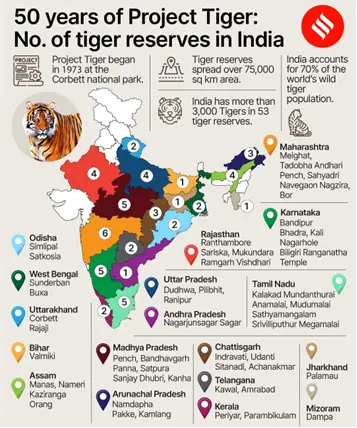
Tiger Reserves in India
- About:
- Tiger Reserves are designated areas aimed at protecting tiger populations and their habitats. They are divided into:
- Core Area: A ‘Critical Tiger Habitat’ managed as an inviolate zone.
- Buffer Area: Surrounding areas with lesser habitat protection.
- Tiger Reserves are designated areas aimed at protecting tiger populations and their habitats. They are divided into:
- Background:
- Project Tiger: Launched in 1973 to safeguard the endangered tiger species, leading to the establishment of various tiger reserves.
- Administration: Managed by the National Tiger Conservation Authority (NTCA).
- Process of Notification:
- Proposal: State governments submit a proposal.
- Approval: NTCA provides in-principal approval and reviews detailed proposals.
- Notification: State governments officially declare the area as a Tiger Reserve.
- Alteration and De-notification:
- Section 38W: Governs changes to boundaries of tiger reserves. Alterations require recommendations from the Tiger Conservation Authority and approval from the National Board for Wildlife. De-notification can only occur with similar approvals and in the public interest.
Chhattisgarh Approves Country’s Third Largest Tiger Reserve
- Approval: Chhattisgarh has approved the creation of the Guru Ghasidas-Tamor Pingla Tiger Reserve.
- Size: The reserve spans 2,829 square kilometres, making it the third largest in India.
- Largest Reserve: Nagarjunasagar Srisailam Tiger Reserve in Andhra Pradesh (3,296.31 sq km).
- Second Largest: Manas Tiger Reserve in Assam (2,837.1 sq km).
- Legal Context: The approval followed a directive from the Chhattisgarh High Court to finalise the reserve status.
- Reserve Composition:
- Guru Ghasidas National Park: Located in Koriya district.
- Tamor Pingla Wildlife Sanctuary: Situated in Surajpur district.
- Geography: The reserve spans Manendragarh-Chirmiri-Bharatpur, Koriya, Surajpur, and Balrampur districts.
- Significance:
- Historical Importance: Guru Ghasidas National Park was once the habitat of the Asiatic cheetah.
- Ecological Benefits: Connects with Jharkhand and Madhya Pradesh, providing a corridor for tiger movement between Bandhavgarh and Palamau Tiger Reserves.
- Economic Impact: Expected to boost eco-tourism and create employment opportunities in the core and buffer zones.
- Financial Support: Additional budget from the National Project Tiger Authority will fund operations and local livelihood projects.
- Declining Tiger Population:
- Current Status: Chhattisgarh's tiger population decreased from 46 in 2014 to 17 in 2022.
- National Trends: A concerning decline in tiger populations has been observed in several states, including Mizoram, Nagaland, Jharkhand, Goa, Chhattisgarh, and Arunachal Pradesh.
Source: TOI
New Schemes for Co-operatives
Why in the news?
- The Ministry of Cooperation, established on July 6, 2021, has been actively working on various initiatives to bolster and expand the cooperative movement in India.
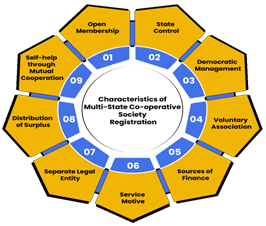
What is a Cooperative?
- A cooperative is defined as an “autonomous association of persons united voluntarily to meet their common economic, social, and cultural needs and aspirations through a jointly owned enterprise.” Key characteristics include:
- Democratic Ownership: Each member has one vote in electing the board of directors.
Evolution of Cooperatives in India:
- Pre-Independence Era:
- First Cooperative Act (1904): Introduced to address rural debt, recommending cooperative credit societies.
- Cooperative Societies Act (1912): Expanded to include non-credit societies.
- Maclagan Committee (1915): Evaluated the economic stability of cooperatives.
- Montague-Chelmsford Reforms (1919): Made cooperation a provincial subject, boosting regional efforts.
- Post-Economic Depression (1929): Regional committees restructured cooperatives.
- Gandhian Influence: Promoted cooperatives for decentralisation and socialistic goals; established cooperative settlements like Phoenix Settlement and Tolstoy Farm in South Africa.
- Post-Independence Era:
- First Five-Year Plan (1951-56): Emphasised cooperatives for community development.
- Multi-State Cooperative Societies Act (2002): Regulated multi-state cooperatives.
- Amendment (2022): Introduced the Co-operative Election Authority for multi-state cooperatives.
- 97th Constitutional Amendment (2011): Made the right to form cooperatives a fundamental right and added Part IX-B to the Constitution.
- Union Ministry of Cooperation (2021): Established to oversee cooperative affairs, previously managed under the Ministry of Agriculture.
Various Initiatives Promoting Cooperatives in India:
- For Making Primary Cooperatives Economically Vibrant and Transparent:
- Model Byelaws for PACS: Enabled PACS to undertake over 25 business activities. Adopted by 32 States/UTs.
- Computerization: ₹2,516 Crore project for computerising PACS. 67,009 PACS from 30 States/UTs sanctioned, with 25,674 using ERP software.
- New Cooperatives: Plan to cover all Panchayats/villages with 6,844 new PACS, Dairy, and Fishery cooperatives.
- Decentralised Grain Storage: Pilot project to extend to 500 additional PACS.
- PACS as Common Service Centers (CSCs): 37,169 PACS providing over 300 e-services.
- Farmer Producer Organizations (FPOs): 1,100 additional FPOs to be formed by PACS; 992 FPOs formed by NCDC.
- Retail Petrol/Diesel Outlets: 270 PACS from 25 States/UTs applied for retail outlets.
- LPG Distributorship: 31 PACS from four States/UTs applied.
- Janaushadhi Kendras: 2,594 PACS given initial approval, 674 received drug licences.
- PMKSK: 38,141 PACS functioning as PMKSK for fertiliser and related services.
- PM-KUSUM: PACS to handle solar water pumps and photovoltaic modules.
- Rural Water Supply: 1,833 PACS identified for O&M of rural piped water schemes.
- Micro-ATMs: 2,700 distributed in Gujarat for doorstep financial services.
- Rupay Kisan Credit Card: 48,000 distributed in Gujarat for lower-interest credit.
- Fish Farmer Producer Organizations (FFPOs): 69 FFPOs registered; 1,000 fisheries cooperatives to be converted.
- For Strengthening Urban and Rural Cooperative Banks:
- New Branches: UCBs allowed to open up to 10% new branches without prior RBI approval.
- Doorstep Services: Banking facilities provided at home.
- One-Time Settlements: Policies for settlement of outstanding loans.
- Extended PSL Targets: Deadline extended to March 31, 2026.
- Nodal Officer for UCBs: Designated in RBI for regular interaction.
- Housing Loan Limit: Doubled to Rs. 60 lakhs for UCBs and Rs. 75 lakhs for rural cooperative banks.
- Diversification: Rural cooperative banks allowed to lend to commercial real estate/housing.
- Reduced Licence Fee: Linked to transaction numbers.
- MLIs in CGTMSE: Risk coverage up to 85% on loans.
- Gold Loan Ceiling: Doubled to Rs. 4 lakh.
- Umbrella Organization: NAFCUB approved to provide IT infrastructure and support.
|
UPSC Civil Services Examination PYQ Prelims Q:1 In India, which of the following have the highest share in the disbursement of credit to agriculture and allied activities? (2011) (a) Commercial Banks (b) Cooperative Banks (c) Regional Rural Banks (d) Microfinance Institutions
Answer: A |
Source: PIB
Yen carries trade
Why in the news?
- Recently, major stock markets across the world experienced their sharpest decline in decades behind this decline was the yen carry trade.
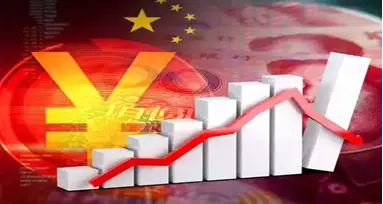
About Yen Carry Trade:
- Definition:
- A trading strategy that involves borrowing at a low interest rate and investing in an asset that provides a higher rate of return.
- Mechanism:
- Typically based on borrowing in a low-interest rate currency and converting the borrowed amount into another currency.
- The proceeds are generally deposited in the second currency if it offers a higher interest rate.
- Alternatively, the proceeds can be deployed into assets such as stocks, commodities, bonds, or real estate that are denominated in the second currency.
- Yen Carry Trade:
- The Japanese yen is considered one of the most widely used currencies for this purpose.
- In yen carry trade, investors, including retail Japanese investors, borrow at a low interest rate at home and purchase assets in another country with higher returns, such as overseas equities and bonds.
- The yen has been popular for carry trades because Japan has maintained a zero-interest rate policy for over two decades.
- The idea behind low interest rates is to stimulate economic activity.
- For instance, such low interest rates incentivize investors to borrow cheaply in yen and invest in other countries (such as Brazil, Mexico, India, and even the US) to earn better returns.
Source: IE
Central Electricity Regulatory Commission
Why in the news?
- Recently, the Central Government of India appointed Shri Harish Dudani as a Member of the Central Electricity Regulatory Commission.
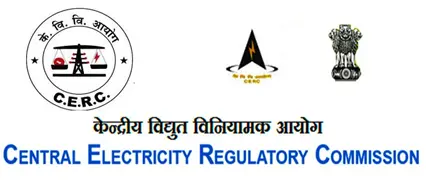
About Central Electricity Regulatory Commission:
- Establishment:
- It is a statutory body established by the Government of India under the provisions of the Electricity Regulatory Commissions Act, 1998.
- It serves as the Central Commission for the purposes of the Electricity Act, 2003, which has repealed the ERC Act, 1998.
- Composition:
- The Commission consists of a chairperson and four other members, including the Chairperson of the Central Electricity Authority, who serves as an ex-officio Member of the Commission.
- Objectives:
- To promote competition, efficiency, and economy in bulk power markets.
- To improve the quality of electricity supply.
- To promote investments in the power sector.
- To advise the government on the removal of institutional barriers to bridge the demand-supply gap.
- To foster the interests of consumers.
- Functions:
- To regulate the tariff of generating companies owned or controlled by the Central Government.
- To regulate the tariff of generating companies, other than those owned or controlled by the Central Government, specified in clause (a) if such generating companies enter into or have a composite scheme for the generation and sale of electricity in more than one State.
- To regulate the inter-State transmission of electricity.
- To determine tariff for inter-State transmission of electricity.
- To issue licences to persons to function as transmission licensees and electricity traders in their inter-State operations
Source: PIB
E-rupee
Why in the news?
- Fintech companies are looking to join the Indian central bank’s digital currency project by allowing their users to transact in e-rupee via Unified Payments Interface (UPI).
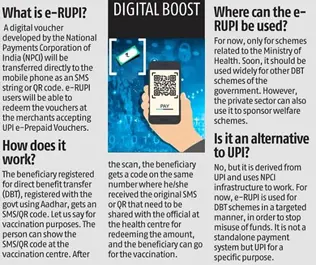
About e-Rupee:
- Definition:
- The e-rupee, or the digital rupee, is a digital currency issued by the Reserve Bank of India (RBI).
- Launch:
- The digital rupee was launched on a pilot basis in December 2022.
- Initially offered by a select group of public and private banks in a few major cities.
- It can be used for both person-to-person and person-to-merchant transactions.
- Purpose:
- It is aimed at creating an additional option for using money.
- The digital rupee is available entirely in electronic form and does not leave a computer network.
- Nature:
- Similar to banknotes issued by the RBI and is a legal tender that can be used to make transactions.
- The only difference is that they can only be transacted online.
- The digital rupee in users’ wallets does not attract interest payments from the central bank.
- Conversion:
- Deposits held in banks can be converted into digital rupees and vice versa for ease of use.
- Categories:
- RBI has demarcated the digital rupee into two broad categories: general purpose (retail) and wholesale.
- This demarcation is based on the usage and the functions performed by the digital rupee and considering the different levels of accessibility.
|
UPSC Civil Services Examination Previous Year Question (PYQ) Prelims Q:1 Consider the following pairs: (2018) Terms sometimes seen in news Context/Topic
Which of the pairs given above is/are correctly matched?
Ans: (b)
Mains Q:1 What is Cryptocurrency? How does it affect global society? Has it been affecting Indian society also? (2021) |
Source: TH
Earth Observation Satellite-8
Why in the news?
- ISRO's Earth Observation Satellite-8 (EOS-8) is expected to be launched by the Small Satellite Launch Vehicle (SSLV)-D3 on August 15 from Sriharikota in Andhra Pradesh.
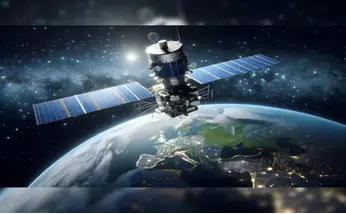
About Earth Observation Satellite-8:
- Launch Vehicle:
- It will be launched by the Small Satellite Launch Vehicle (SSLV)-D3.
- Objective:
- The primary objectives of the EOS-08 mission include:
- Designing and developing a microsatellite.
- Creating payload instruments compatible with the microsatellite bus.
- Incorporating new technologies required for future operational satellites.
- The primary objectives of the EOS-08 mission include:
- Structure:
- It is built on the Microsat/IMS-1 bus and carries three payloads:
- Electro Optical Infrared Payload (EOIR):
- Designed to capture images in the Mid-Wave IR (MIR) and Long-Wave IR (LWIR) bands, both during the day and night.
- Applications: satellite-based surveillance, disaster monitoring, environmental monitoring, fire detection, volcanic activity observation, and industrial and power plant disaster monitoring.
- Global Navigation Satellite System-Reflectometry payload (GNSS-R):
- Demonstrates the capability of using GNSS-R-based remote sensing.
- Applications: ocean surface wind analysis, soil moisture assessment, cryosphere studies over the Himalayan region, flood detection, and inland waterbody detection.
- SiC UV Dosimeter:
- Monitors UV irradiance at the viewport of the Crew Module in the Gaganyaan Mission.
- Serves as a high-dose alarm sensor for gamma radiation.
- Electro Optical Infrared Payload (EOIR):
- It is built on the Microsat/IMS-1 bus and carries three payloads:
- Mission Life:
- The spacecraft has a mission life of one year.
Source: IE
Five years after end of Article 370
Context:
- On 5th August 2019, India made a significant constitutional change regarding the status of Jammu and Kashmir (J&K) by abrogating Articles 370 and 35A.
- This move has had profound implications for the region and its relations with Pakistan.
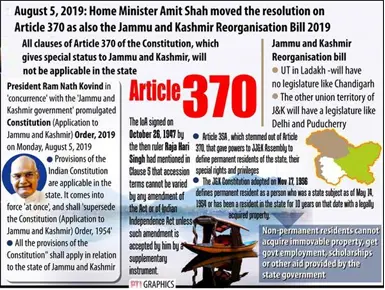
Article 370 of the Constitution of India:
- About Article 370:
- Article 370 was added to the Indian Constitution on October 17, 1949, as a 'temporary provision.'
- It exempted Jammu & Kashmir (J&K) from the Indian Constitution, allowing it to draft its own Constitution and limiting the Indian Parliament's legislative authority in the state.
- This article was introduced into the draft constitution by N. Gopalaswami Ayyangar as Article 306A.
- Provisions Under Article 370:
- The Constituent Assembly of Jammu & Kashmir had the authority to decide which articles of the Indian Constitution would apply to the state.
- The J&K Constituent Assembly was dissolved after completing the drafting of the state's constitution.
- Presidential Powers:
- Clause 3 of Article 370 grants the President of India the power to amend its provisions and scope.
Article 35A:
- Origin: Article 35A derives from Article 370 and was introduced through a Presidential Order in 1954, based on the recommendation of the J&K Constituent Assembly.
- Provisions: It authorises the Jammu & Kashmir legislature to define permanent residents of the state and their special rights and privileges.
- Modifications on 5th August 2019:
- Presidential Order: The President of India used the powers granted by Clause (1) of Article 370 to issue the Constitution (Application to Jammu and Kashmir) Order, 2019.
- Impact: This order allowed the Government of India to modify Article 370 itself (rather than revoking it).
The Aftermath of Abrogation of Article 370:
- India's Definite Stand on J&K's Status
- Clarified Relationship: By removing ambiguity about J&K's relationship with India, Delhi has firmly ended the notion that the region's status is open-ended or negotiable.
- Established Stance: This action clearly states that J&K is an integral part of India and is not up for discussion.
- Global Influence: Strengthening partnerships with Western nations has reduced the efforts by Pakistan and China to internationalise the Kashmir issue, making it less prominent globally.
- Persistent Bilateral Conflict: Despite these changes, the Kashmir issue remains relevant in the bilateral conflict between India and Pakistan.
- Continued Cross-Border Tensions
- Pakistan's Meddling: Pakistan's capacity to interfere in Kashmir remains unchanged despite the constitutional change.
- Increased Terrorism: There has been a surge in cross-border terrorism, especially since Narendra Modi's third term as Prime Minister, highlighting the ongoing threat.
- Legal vs. Practical Reality: Delhi is aware of the gap between legal formalism on Kashmir and the practical reality of Pakistan’s continued interference.
- Political Gains and Persistent Challenges
- Electoral Success: Post-abrogation of Article 370, parliamentary elections in Kashmir have shown significant political gains for Delhi.
- Continued Separatism: However, separatist sentiments persist, indicating ongoing challenges.
- Domestic Tasks: Delhi must remain vigilant as substantial domestic tasks in Kashmir remain.
- Global Impact: India has reduced the global prominence of the Kashmir issue, but it still poses challenges requiring careful management.
What are the developments and initiatives in Jammu & Kashmir (J&K):
- Development Projects:
- Infrastructure Improvements: The government has launched numerous development projects focusing on road and rail connectivity, health and education infrastructure, tourism promotion, and youth empowerment.
- Prime Minister’s Development Package (PMDP): 54 projects have been sanctioned under the PMDP to enhance various sectors in J&K.
- Central Government Schemes: Implementation of flagship schemes such as Ayushman Bharat, Ujjwala Yojana, PM Kisan Samman Nidhi, and PM Awas Yojana.
- Under Ayushman Bharat, over 21 lakh beneficiaries have been registered, and more than 1.5 lakh have received free treatment in J&K.
- Tourism and Investment Promotion:
- Hosted the G20 Tourism Working Group meeting in Srinagar, marking the first significant international event aimed at integrating J&K with global and national networks.
- Conducted other business meetings and a Global Investors Summit in June 2022 with participation from over 200 domestic and foreign companies, showcasing investment opportunities in sectors like agriculture, horticulture, handicrafts, tourism, IT, and renewable energy.
- Political Reforms:
- Grassroots Democracy: Conducted the first-ever District Development Council (DDC) elections in December 2020 with a voter turnout of 51.42%.
- Legislative Amendments: Amended the Jammu and Kashmir Panchayati Raj Act, 1989 to include reservations for women, scheduled castes, scheduled tribes, and backward classes in panchayats.
- Delimitation Process: Initiated the process to redraw assembly and parliamentary constituencies based on the latest census data.
- Security Measures:
- Counter-Terrorism: Eliminated more than 800 terrorists and arrested over 5,000 overground workers of terrorist outfits in the last four years.
Developments in the UT of Ladakh:
- Infrastructure:
- Zojila Tunnel: Accelerated work on the Zojila tunnel to provide all-weather connectivity between Srinagar and Leh.
- Leh Airport Expansion: Increased passenger capacity and facilitated more flights to and from Ladakh.
- Telecommunication Network: Improved by laying fibre-optic cables and installing solar-powered towers to ensure internet and mobile services in remote villages.
- Education:
- Skill Development: Provided employment-oriented training to over 75,000 youths in Ladakh.
- Educational Institutions: Established one new medical college, one engineering college, and one National Skill Training Institute in Ladakh.
- Health:
- AIIMS-like Institutes: Set up two new AIIMS-like institutes in Leh and Kargil.
- Health Insurance Scheme: Launched under Ayushman Bharat Pradhan Mantri Jan Arogya Yojana (AB-PMJAY) for all residents of Ladakh.
- Employment:
- Tourism and Adventure Sports: Promoted by easing travel restrictions and offering incentives to tourists and operators.
- Organic Farming and Horticulture: Developed by providing subsidies and market linkages to farmers and cooperatives.
- Governance:
- Hill Council for Kargil: Constituted to ensure local representation and autonomy.
- Local Elections: Held for panchayats and urban local bodies to promote grassroots democracy
Challenges Faced by the Union Territory of Jammu & Kashmir (J&K):
- Rise in Targeted Killings:
- Increased Violence: There has been a notable rise in targeted killings, particularly of Kashmiri Hindus and non-Kashmiris (migrant labourers).
- Recent Statistics: Over 50% of civilian killings since August 5, 2019, occurred in the past eight months.
- Weaponry: Small weapons have been dropped by low-cost drones from across the border, used in these attacks.
- Crimes Against Women and Children: There is an upward trend in crimes against women and children.
- Detentions and Suppression of Opinion:
- Preventive Detentions: Over 5,000 individuals were detained to prevent protests against the abrogation actions of August 5 and 9, 2019.
- Restriction on Expression: Journalists and human rights defenders have been imprisoned for expressing dissenting opinions.
- Resurgence of Militancy:
- Reemergence in Pir Panjal: Militancy has resurfaced in the Pir Panjal region, which had seen a decline over the past 15 years.
- Increased Casualties: There has been a significant rise in casualties among CRPF troops since 2019.
- Suppression of Political Voices:
- House Arrests: Political leaders in J&K have been subject to occasional house arrests for several years, particularly around the anniversary of the revocation of Article 370.
- Prohibition on Protests: Leaders are denied permission to protest peacefully, and their offices are frequently sealed.
- Economic Issues: Land alienation, cessation of cross-border trade, and the decline of local businesses continue to be significant issues.
- Election Delays: Legislative elections have been postponed for five years since the abrogation of Article 370.
- Unemployment and Corruption:
- High Unemployment Rate: The unemployment rate is alarmingly high at 23.1%, significantly above the national average.
- Job Placements: While some government job placements have occurred, many vacancies remain unfilled.
Challenges Faced by the Union Territory of Ladakh:
- Border Disputes:
- Conflict with China: Ladakh shares disputed borders with Pakistan and China. The 2020 clash in the Galwan Valley with China was volatile and raised concerns about regional peace and security.
- Restrictions on Herding: Indian cattle herders face restrictions by Chinese forces near the Line of Actual Control (LAC) until the border dispute is resolved.
- Development Gap:
- Infrastructure and Services: Issues include poor connectivity, low literacy rates, high mortality, limited opportunities, and weak institutions.
- Concerns Arising After UT Formation:
- Four-Point Agenda: Leading organisations like the Kargil Democratic Alliance and Ladakh Buddhist Association demand:
- Statehood for Ladakh, with an elected Assembly.
- Safeguards under the Sixth Schedule of the Constitution to protect Ladakh's environment and indigenous rights.
- Job reservations for Ladakh’s youth.
- Creation of separate parliamentary constituencies for Leh and Kargil.
- Statehood Demand: Ladakh's residents have been demanding full statehood, feeling that UT status does not offer sufficient autonomy or representation and fearing demographic changes and cultural erosion.
- Regional Divide: Leh (predominantly Buddhist) and Kargil (predominantly Muslim) have different religious, ethnic, linguistic compositions, and political aspirations.
- Cultural Identity: Ladakh has a distinct cultural identity influenced by Tibetan, Balti, Dardic, Mongoloid, and Indo-Aryan elements. There is a strong desire to preserve and promote this cultural heritage amid modernization.
- Local Protests: Sonam Wangchuk, a Ladakhi engineer and educator, has protested for greater autonomy and regional demands, accusing the LG of Ladakh of favouring J&K’s status over Ladakh’s needs.
- Four-Point Agenda: Leading organisations like the Kargil Democratic Alliance and Ladakh Buddhist Association demand:
Recommended Approach for Navigating the Post-Abrogation Landscape in Jammu and Kashmir and Ladakh
- Restoring Normalcy and Trust:
- Rebuild Trust: Implement measures to restore normalcy and build trust among the local population.
- Release Detainees: Free political detainees and foster an environment conducive to dialogue.
- Engage Local Leaders: Actively engage with local leaders and communities to address grievances and promote reconciliation.
- Inclusive Governance and Participation:
- Promote Inclusivity: Ensure governance structures reflect the diverse aspirations of the region’s inhabitants.
- Conduct Local Elections: Expedite local elections to empower regional political platforms and enhance grassroots democracy.
- Economic Development and Investment:
- Drive Economic Growth: Focus on economic development through infrastructure projects, tourism, and technology advancements.
- Special Economic Zones: Establish special economic zones, provide incentives for investment, and support small and medium-sized enterprises (SMEs).
- Strengthening Security and Peace:
- Ensure Stability: Prioritise security and stability to create a conducive environment for development.
- Counter Insurgency: Intensify efforts to counter insurgency and strengthen local law enforcement agencies.
- Respecting Cultural Diversity:
- Acknowledge Diversity: Recognize and respect the cultural and ethnic diversity of the regions.
- Preserve Culture: Take measures to preserve cultural heritage while balancing regional interests.
- Infrastructure and Connectivity:
- Enhance Connectivity: Develop and improve connectivity for trade and tourism.
- Boost Digital Infrastructure: Invest in digital infrastructure, education, and business development to foster growth.
- International Diplomacy:
- Manage External Perceptions: Clearly communicate India’s stance on the issues to manage international perceptions effectively.
- Address Border Disputes: Engage in diplomatic efforts to resolve border disputes and strengthen relations with neighbouring countries.
|
UPSC Civil Services Examination Previous Year’s Question (PYQs) Prelims: Q:1 Siachen Glacier is situated to the (2020)
Ans: (d)
Mains: Q:1 To what extent is Article 370 of the Indian Constitution, bearing marginal note “Temporary provision with respect to the State of Jammu and Kashmir”, temporary? Discuss The future prospects of this provision in the context of Indian polity. (2016) Q:2 Analyze internal security threats and transborder crimes along Myanmar, Bangladesh and Pakistan borders including Line of Control (LoC). Also discuss the role played by various security forces in this regard. (2020) Q:3 The banning of ‘Jamaat-e-islaami’ in Jammu and Kashmir brought into focus the role of over-ground workers (OGWs) in assisting terrorist organisations. Examine the role played by OGWs in assisting terrorist organisations in insurgency affected areas. Discuss measures to neutralise the influence of OGWs. (2019) Q:4 The states of Jammu and Kashmir, Himachal Pradesh and Uttarakhand are reaching the limits of their ecological carrying capacity due to tourism. Critically evaluate. (2015) |
Source: IE
Share the article
Edukemy’s Current Affairs Quiz is published with multiple choice questions for UPSC exams
MCQ
Get Latest Updates on Offers, Event dates, and free Mentorship sessions.

Get in touch with our Expert Academic Counsellors 👋
FAQs
UPSC Daily Current Affairs focuses on learning current events on a daily basis. An aspirant needs to study regular and updated information about current events, news, and relevant topics that are important for UPSC aspirants. It covers national and international affairs, government policies, socio-economic issues, science and technology advancements, and more.
UPSC Daily Current Affairs provides aspirants with a concise and comprehensive overview of the latest happenings and developments across various fields. It helps aspirants stay updated with current affairs and provides them with valuable insights and analysis, which are essential for answering questions in the UPSC examinations. It enhances their knowledge, analytical skills, and ability to connect current affairs with the UPSC syllabus.
UPSC Daily Current Affairs covers a wide range of topics, including politics, economics, science and technology, environment, social issues, governance, international relations, and more. It offers news summaries, in-depth analyses, editorials, opinion pieces, and relevant study materials. It also provides practice questions and quizzes to help aspirants test their understanding of current affairs.
Edukemy's UPSC Daily Current Affairs can be accessed through:
- UPSC Daily Current Affairs can be accessed through Current Affairs tab at the top of the Main Page of Edukemy.
- Edukemy Mobile app: The Daily Current Affairs can also be access through Edukemy Mobile App.
- Social media: Follow Edukemy’s official social media accounts or pages that provide UPSC Daily Current Affairs updates, including Facebook, Twitter, or Telegram channels.

